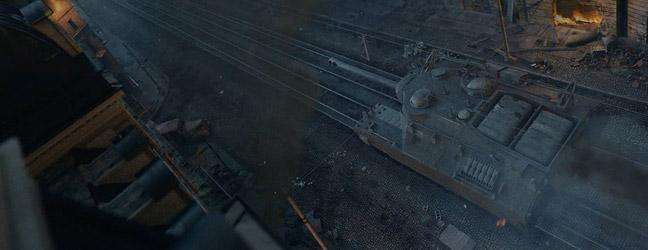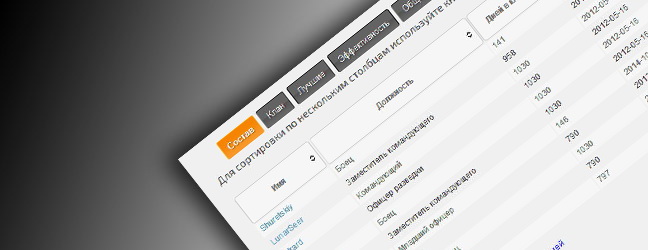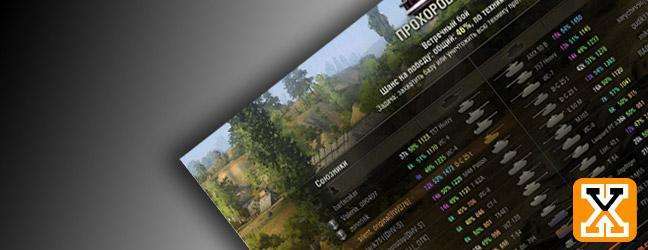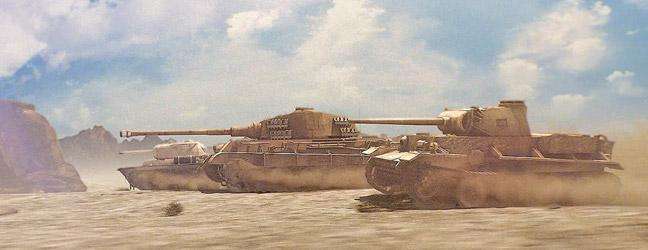JagdTiger - Thick-Skinned Cat
Дата: 29.04.2011 20:19:15
admin: 
JagdTiger – full name of the vehicle is Panzerjäger Tiger – German tank destroyer (TD) of the final WWII period. According to the German departmental designations system for military equipment JagdTiger had its own index – Sd.Kfz.186. This tank destroyer was developed in 1942-1944 on the chassis of a heavy tank Tiger II and has become the heaviest large-scale production model of military vehicles of all time.
***
The first batch of the vehicles came out of the manufacturing plant’s gates in March 1944. All of them began their service in the third company of the 130th training antitank battalion. This battalion also had such tank destroyers as Jagdpanzer IV and Marder. All 14 vehicles of this type were divided into three platoons of four tank destroyers and, while the two remaining tank destroyers were used as command and staff vehicle. There is no information about the battle actions of the battalion during 1944. What is really interesting - according to the German data, the half of these vehicles had a typical camouflage and the other half was painted gray.
The subsequent batches of JagdTigers were destined to supply heavy tank battalions 512 and 653. Heavy Antitank Battalion 512 was formed in Paderborn on 11 February 1945 (commander – hauptmann Scherf). In March 1945 the first Company of the Battalion joined the battles near Remagent Bridge. At this time the Company had only half of the JagdTigers (6 vehicles) but, in spite of this, successfully destroyed allied tanks and suffered almost no losses.
The second Company of the Battalion was recycled to Siegburg by railway. 3 JagdTigers were lost due to the strikes of Allied air forces. The remaining Tank Destroyers participated the battles in the Ruhr Pocket in April 1945. They destroyed 36-40 American tanks within 4-5 days of the battle actions. The remains of the 1st and 2nd Companies surrendered to the British and American forces near Iserlohn. Partially the vehicles were destroyed by their crews.
Nine JagdTigers of the 512 Battalion were sent to Austria, where they successfully operated in the line of the 6th SS Panzer Army. Despite numerous malfunctions, this unit caused tangible losses to the Soviet tank units that didn’t have any equivalent vehicles to oppose. By the end of May 9, 1945 the remains of the unit (3 tank destroyers) defueled all secondary vehicles to fill the tanks of their JagdTigers and attempted the breakthrough to the demarcation line. During this operation 2 IS-2 and KV-85 were destroyed. The remains of the unit surrendered to American forces. To honor soviet tank crews it is should be mentioned that one JagdTigers was severely damaged and then destroyed by its own crew.
Heavy Antitank Battalion 635, which was previously equipped with Ferdinands, joined the battles in early December 1944 assigned to the 5th Tank Army. This unit had only 9 JagdTigers by that time. Despite the shortage of personnel and materiel, the Battalion inflicted great losses on the attacking British and American tank troops, armed mainly by Shermans. They were excellent targets for the German gunners due to their tall silhouettes. On 7 December a lonesome JagdTiger, which was guarding the crossroad, destroyed 19 Shermans within 3 hours. Moreover, it wasn’t even damaged. All the hits couldn’t pierce its armor (by the way, according to the assertions of the Germans, the Americans were shooting poorly and hit the JagdTiger only 4 times and all 4 shells were ricochet. During the battles in December the amount of JagdTigers had grown up to 16 vehicles. On December 23, 1944 the Battalion was assigned to the Army Group G and took part in the battle actions during the Operation “North Wind”. On the eve of the New Year 6 vehicles of the Battalion relocated to the area near Bonn due to the difficulties with rail transportation. These 6 JagdTigers participated in the defense of the city.
Later on, the Battalion was regularly used against American troops in southern Germany, causing the enemy heavy losses. May 6, 1945 several JagdTigers were surrounded by Soviet troops and tried to breakthrough to the American occupation zone. Soviet antitank guns hit one JagdTigers in suspension and the vehicle was captured. Today this tank destroyer is being exhibited in the tank museum at Kubinka. The remain JagdTigers of the Battalion were destroyed by their crews near the Austrian boarder just before the surrender.
Additionaly, there are different comments on JagdTiger participation in Seelow heights and Berlin battles, but none of them are considered to be certain. But some recalls seem to be believable - Vasiliy Gnidyuk, WWII Guards Senior Lieutenant (1st Guards Mechanized Corps), recollects that he tried to knock down a "new 122-mm gunned Ferdinand" from Sherman during the battle on the outskirts of Vienna. He mentions that the SPG "was under the cover of a stone wall and shot along the streets, knocking down all passing-by vehicles with a single shot."
According to his words, firing that SPG with his gun was useless, and in the end, infantry set it on fire with faustpatrones "at the third or fourth attempt." Undoubtedly, JagdTiger outclassed all SPGs of anti-Hitler coalition and of the Third Reich in the anti-tank armament. At least until 1948 there were no tanks in the world that could sustain even a direct fire shot of this vehicle. PaK 44 gun was produced on the basis of anti-aircraft guns and had the barrel length of 55 calibers. This weapon could hit any tank at all reasonable fighting ranges.
However, this self-propelled gun had a set of significant drawbacks, most important of them were the following:
- JagdTiger's suspension was extremely overloaded, and that resulted in low reliability of the vehicle. For this reason, the design of the SPG nominally consisted of two stationary explosive charges for its destruction in case of a technical failure. One charge was placed under the engine, the second one was put under the gun breech.
20
- The engine power of 700 hp was obviously insufficient for a vehicle weighing 75 tons. As a result, the SPG was non-mobile, and that reduced the benefits of the super-heavy front armor and weapon to some extent. As a comparison, a similar engine was installed on Panther tank, which weighed 30 tons less, but due to its weight still had little mobility. For this reason, self-propelled gun was mainly used in the shelters at fixed positions, where its low driving performance did not play a special role.
- In terms of enemy quantitative superiority, the attack on Jagdtiger flank was more than probable due to the absence of turret rotation and low firing rate caused by separate loading. In 1944-45 JagdTiger's side armor did not provide enough protection from tank and antitank guns of the anti-Hitler coalition. This circumstance made the vehicle vulnerable to infantry attacks, where close range antitank means of weapon were used - rocket-propelled grenades Bazooka and Molotov cocktails.
- Low maneuverability and a very large size did not let the vehicle escape air strike, and many JagdTiger SPGs were disabled by ally aviation.
- Expensiveness and complex technologies of production.
This SPG was extremely heavy and easily stuck in soft soil (a tillage). Moreover, sometimes it could not pass a bridge due to its heavy weight.
- The famous tanker Otto Karius considered the extremely low level of crew training to be the most important problem of JagdTiger. Eventually, this problem led to significant combat and non-combat (caused by a breakdown) losses.
As a result, the number of produced vehicles was very small, and JagdTigers did not influence the battle outcome significantly.

JagdTiger – full name of the vehicle is Panzerjäger Tiger – German tank destroyer (TD) of the final WWII period. According to the German departmental designations system for military equipment JagdTiger had its own index – Sd.Kfz.186. This tank destroyer was developed in 1942-1944 on the chassis of a heavy tank Tiger II and has become the heaviest large-scale production model of military vehicles of all time.
***
The first batch of the vehicles came out of the manufacturing plant’s gates in March 1944. All of them began their service in the third company of the 130th training antitank battalion. This battalion also had such tank destroyers as Jagdpanzer IV and Marder. All 14 vehicles of this type were divided into three platoons of four tank destroyers and, while the two remaining tank destroyers were used as command and staff vehicle. There is no information about the battle actions of the battalion during 1944. What is really interesting - according to the German data, the half of these vehicles had a typical camouflage and the other half was painted gray.
The subsequent batches of JagdTigers were destined to supply heavy tank battalions 512 and 653. Heavy Antitank Battalion 512 was formed in Paderborn on 11 February 1945 (commander – hauptmann Scherf). In March 1945 the first Company of the Battalion joined the battles near Remagent Bridge. At this time the Company had only half of the JagdTigers (6 vehicles) but, in spite of this, successfully destroyed allied tanks and suffered almost no losses.
The second Company of the Battalion was recycled to Siegburg by railway. 3 JagdTigers were lost due to the strikes of Allied air forces. The remaining Tank Destroyers participated the battles in the Ruhr Pocket in April 1945. They destroyed 36-40 American tanks within 4-5 days of the battle actions. The remains of the 1st and 2nd Companies surrendered to the British and American forces near Iserlohn. Partially the vehicles were destroyed by their crews.
Nine JagdTigers of the 512 Battalion were sent to Austria, where they successfully operated in the line of the 6th SS Panzer Army. Despite numerous malfunctions, this unit caused tangible losses to the Soviet tank units that didn’t have any equivalent vehicles to oppose. By the end of May 9, 1945 the remains of the unit (3 tank destroyers) defueled all secondary vehicles to fill the tanks of their JagdTigers and attempted the breakthrough to the demarcation line. During this operation 2 IS-2 and KV-85 were destroyed. The remains of the unit surrendered to American forces. To honor soviet tank crews it is should be mentioned that one JagdTigers was severely damaged and then destroyed by its own crew.
Heavy Antitank Battalion 635, which was previously equipped with Ferdinands, joined the battles in early December 1944 assigned to the 5th Tank Army. This unit had only 9 JagdTigers by that time. Despite the shortage of personnel and materiel, the Battalion inflicted great losses on the attacking British and American tank troops, armed mainly by Shermans. They were excellent targets for the German gunners due to their tall silhouettes. On 7 December a lonesome JagdTiger, which was guarding the crossroad, destroyed 19 Shermans within 3 hours. Moreover, it wasn’t even damaged. All the hits couldn’t pierce its armor (by the way, according to the assertions of the Germans, the Americans were shooting poorly and hit the JagdTiger only 4 times and all 4 shells were ricochet. During the battles in December the amount of JagdTigers had grown up to 16 vehicles. On December 23, 1944 the Battalion was assigned to the Army Group G and took part in the battle actions during the Operation “North Wind”. On the eve of the New Year 6 vehicles of the Battalion relocated to the area near Bonn due to the difficulties with rail transportation. These 6 JagdTigers participated in the defense of the city.
Later on, the Battalion was regularly used against American troops in southern Germany, causing the enemy heavy losses. May 6, 1945 several JagdTigers were surrounded by Soviet troops and tried to breakthrough to the American occupation zone. Soviet antitank guns hit one JagdTigers in suspension and the vehicle was captured. Today this tank destroyer is being exhibited in the tank museum at Kubinka. The remain JagdTigers of the Battalion were destroyed by their crews near the Austrian boarder just before the surrender.
Additionaly, there are different comments on JagdTiger participation in Seelow heights and Berlin battles, but none of them are considered to be certain. But some recalls seem to be believable - Vasiliy Gnidyuk, WWII Guards Senior Lieutenant (1st Guards Mechanized Corps), recollects that he tried to knock down a "new 122-mm gunned Ferdinand" from Sherman during the battle on the outskirts of Vienna. He mentions that the SPG "was under the cover of a stone wall and shot along the streets, knocking down all passing-by vehicles with a single shot."
According to his words, firing that SPG with his gun was useless, and in the end, infantry set it on fire with faustpatrones "at the third or fourth attempt." Undoubtedly, JagdTiger outclassed all SPGs of anti-Hitler coalition and of the Third Reich in the anti-tank armament. At least until 1948 there were no tanks in the world that could sustain even a direct fire shot of this vehicle. PaK 44 gun was produced on the basis of anti-aircraft guns and had the barrel length of 55 calibers. This weapon could hit any tank at all reasonable fighting ranges.
However, this self-propelled gun had a set of significant drawbacks, most important of them were the following:
- JagdTiger's suspension was extremely overloaded, and that resulted in low reliability of the vehicle. For this reason, the design of the SPG nominally consisted of two stationary explosive charges for its destruction in case of a technical failure. One charge was placed under the engine, the second one was put under the gun breech.
20
- The engine power of 700 hp was obviously insufficient for a vehicle weighing 75 tons. As a result, the SPG was non-mobile, and that reduced the benefits of the super-heavy front armor and weapon to some extent. As a comparison, a similar engine was installed on Panther tank, which weighed 30 tons less, but due to its weight still had little mobility. For this reason, self-propelled gun was mainly used in the shelters at fixed positions, where its low driving performance did not play a special role.
- In terms of enemy quantitative superiority, the attack on Jagdtiger flank was more than probable due to the absence of turret rotation and low firing rate caused by separate loading. In 1944-45 JagdTiger's side armor did not provide enough protection from tank and antitank guns of the anti-Hitler coalition. This circumstance made the vehicle vulnerable to infantry attacks, where close range antitank means of weapon were used - rocket-propelled grenades Bazooka and Molotov cocktails.
- Low maneuverability and a very large size did not let the vehicle escape air strike, and many JagdTiger SPGs were disabled by ally aviation.
- Expensiveness and complex technologies of production.
This SPG was extremely heavy and easily stuck in soft soil (a tillage). Moreover, sometimes it could not pass a bridge due to its heavy weight.
- The famous tanker Otto Karius considered the extremely low level of crew training to be the most important problem of JagdTiger. Eventually, this problem led to significant combat and non-combat (caused by a breakdown) losses.
As a result, the number of produced vehicles was very small, and JagdTigers did not influence the battle outcome significantly.
 News from the Front\Developers Blog\JagdTiger - Thick-Skinned Cat
News from the Front\Developers Blog\JagdTiger - Thick-Skinned Cat













